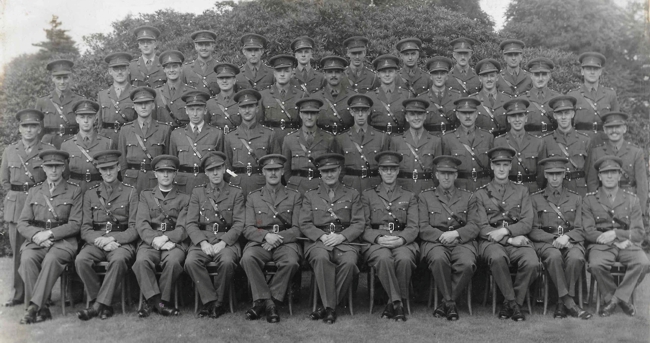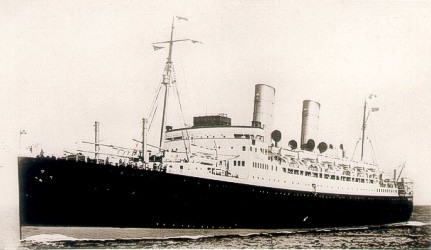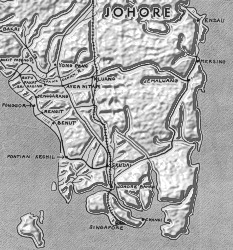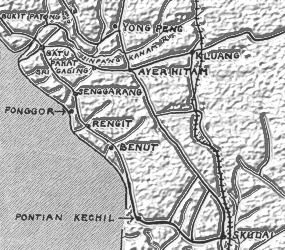|

5th Battalion
Please click on the above photo to enlarge

Officers of 5th Battalion
Please click on the above photo to enlarge
The orders to double the 5th battalion in 1938 was seen to be a good move as the battalion was up to strength when war was declared in 1939. The object was then to split the battalion into two, making the 5th and 7th battalions. On the 1st October 1939 this became a reality and two battalions were formed and trained seperatly.
The Battalion HQ was at Dereham with Lt.-Col. G.N.Scot-Chad in command with other units at Aylsham, North Walsham and Holt. For the first few months individual training was at Holt and Weyborne and the men were given the task of building and manning the North Norfolk Coastal Defences. The battalion colours were in Sheringham Church, as Lt.-Col. Scot-Chad carried the Kings Colours and Maj.B.Savory the Regiment Colours.
In March 1940 section training begun and Lt-Col. E.C.Prattley, who had served with the 2nd Battalion in France, took over command of the battalion and Maj. H.T.Crane took over as second in command. In May company training begun only to be interrupted during the early summer months, after Dunkirk and with the threat of invasion, the battalion was given the job of manning the Coastal Defences at Weyborne. Whilst building the defences they carried on with their training and were achieving a high degree of skill as a unit.
With the threat of an invasion past the battalion was issued with transport vehicles and advanced training was then carried out. The battalion was moved to Gresham School at Holt in September and they now had an assault course in the woods. Being now brigaded with the 6th Royal Norfolks and the 2nd Cambridgeshires to be part of the 53 Brigade of the 18 Division, brigade training was applied.
A move to Kings Lynn in October had the battalion billeted in the uncomfortable warehouses in the dock area. They stayed here until January 7th 1941, having seen a few air raids on the town, they then moved by train to Scotland for advanced training. The troops were developing into a fighting unit under the Scottish route marches, and apart from helping in Glasgow after a heavy air raid it was all training.
On April 7th the brigade was moved to Northwich, near Liverpool, this move had two reasons. The city had very heavy bombing raids and needed the troops for fire watching duties plus full scale brigade attacks were to be carried out in the Birmingham and Carlisle districts. The battalion took alternate roles in attack and defence in these excercises. They were now a fighting team ready for action. One final move on Ocober 5th was back to Glasgow where on the 22nd a detatchment of one officer and 55 other ranks were inspected by the King before going overseas.
The battalion embarked on the Duchess of Atholl (21,000 tons) on the 9th December and sailed for Halifax with the 18th Infantry Division convoy.
|

|
|
Duchess of Atholl - 21,000 tons
|
|
In Canada they were transhipped to the U.S.S. Mount Vernon (26,000, formally the Washington) along with the rest of the 53 Brigade. Leaving Halifax on the 10th November for Trinidad and then reached Cape Town on December 9th, where four days were spent sleeping on board. The convoy carrying the 18th Division sailed for Bombay on December 13th but the Mount Vernon was then ordered to turn back as her destination would be Mombassa, arriving there on Christmas Day, where shore leave was granted. On 28th December she sailed again and it was then announced her destination was Singapore. The troops knew of the Japanese invasion of Malaya, nd were given lectures on jungle warfare whilst sailing across the Indian Ocean before reaching her destination on January 13th 1942.
The troops disembarked in pouring rain and settled in at Woodlands Camp which was near the navel base.
Johore - Malaya
|

|
|
Johore - Malaya
|
|
Detail from Royal Norfolk Regiment
|
|
Before the troops were moved, some hurried jungle training took place by officers who had been fighting in Malaya. This training was very sparse as the troops were needed to stop the Japanese who had landed and infiltrated behind the allied lines in Malaya.
The 53 Infantry Brigade moved into Jahore on the 16th January and were under the command of the 11th Indian Division.
Moving in military transport they reached the area of Ayer Hitam and took up positions around Yong-Peng but very soon were on the move again to Jemaluang, east of Ayer Hitam. Having made no contact with the Japanese the battalion was moved into divisional reserve at Ayer Hitam on the 20th January.
|

|
|
Jahore
|
|
Detail from Royal Norfolk Regiment
|
|
The first clash happened on the next day when a patrol was ambushed by a forward Japanese patrol, this left two injured and one missing. The Japanese were attacking the coast at Batu Pahat and also trying to infiltrate the allied lines by landing troops further south near Senggarang and Rengit which was over ten miles behind their present positions.
That evening the road from Ayer Hitam to Batu Pahat was crossed by the Japanese but the next morning the road was still in allied hands. It fell to the battalion to keep it open, at 4pm the enemy crossed the road again and gained possession near the 73rd milestone.
Capt. S.C.H.Boardman leading “D” company made contact with the enemy near their road block, the casualties included the company commander. The battalion were then ordered to move to Batu Pahat but as the road was blocked they stayed at the 72 milestone and prepared an attack on the Japanese block for the next morning.
The following morning the battalion found the road block to be heavily defended. Capt. A.J.Self attacked with “B” Company but received many casualties including 2nd/Lt.McKean who was killed, later Lt. G.H.Pallister died of his injuries, they were driven back. “C” company led by Maj. C.P.Wood managed to get round the southern side of the road block but the battalion was then recalled to take temporary positions near Ayer Hitam.
Later that evening the battalion made a detour south from Ayer Hitam spending the night near Skudai. Starting early they went through Pontain Ketchil and Rengit reaching the outskirts of Batu Pahat at 7am the morning of the 24th. They met the 2nd Cambridgeshires who had been ordered to withdraw from the town. The Royal Norfolks were given the task of retaking positions in the centre of the town as a holding operation to allow other troops to withdraw, the operation began at 10.45am. With very little artillery support the task was partly successful, the right flank being heavily engaged by the enemy, there was a constant threat of the enemy getting behind them and cutting off a withdrawal, these threats cam from two high spots overlooking their positions and held by the Japanese. “B” company was given the task of clearing these high positions of the enemy, which they did only to be later driven off themselves. At 4am on the 25th “C” Company with the remainder of the 2nd Cambridgeshires attacked these high points again but were stopped by heavy machine gun fire making an advance impossible. The battalion were then ordered to hold their present positions and cover the 2nd Cambridgeshires withdrawal. At 9pm, the task completed, the battalion withdrew four miles out of Batu Pahat.
On the morning of the 26th January the battalion found the Japanese had landed south of their lines and cut off their withdrawal. An attempt was made to clear the road for the transport but failed. The Brigade Commander sent orders at 5.45pm to destroy the 250 transport vehicles and continue on foot through the jungle. It was to be a long strenuous 18 mile journey which on the top of the five days of fighting took its toll.
The biggest part of the battalion, 500 in total, kept together under Maj. Wood and reached Benet on the coastal road on the evening of the 27th.
Capt. H.E.Schulman led a party to the coast and were evacuated by the Royal Navy. The men left behind to blow the bridge at Senggarang were cut off from the main party but with the C.O. they successfully made their way to the coast and escaped in a canoe.
The following day, 28th January, the battalion was taken to Serangoon Road Camp on Singapore Island and all allied troops were ordered to fall back to Singapore.
Singapore
|

|
|
Singapore
|
|
Detail from Royal Norfolk Regiment
|
|
Between the 28th and the 30th the battalion reorganised, were issued with equipment and prepared defensive positions, all the time more men arrived back from Malaya. The remainder of the 18th Division arrived on the 29th but the 53rd remained under the 11th Indian Division. Their area to defend was the centre of the island which included much of Singapore itself.
Singapore was subjected to heavy bombing and on February 3rd the battalion moved into the Navel base to build defences, Maj. Wood was injured during an air raid.
The Japanese landed in the North East of the island and this began to restrict the battalions forward line, on February 12th they were ordered to withdraw to the Breddel Road area. During the night of 13th-14th “A” company was attacked on the battalions right forward position, the Japanese were driven back causing heavy casualties amongst them. Later the Japanese gained an advantage by outflanking the left side driving back the 2nd Cambridgeshires, leaving the battalion exposed. Counter attacking the ground was recaptured but the darkness and with good use of infiltration, the Japanese got in between the battalions lines. During the 14th it was quiet but when the darkness came again the Japanese tried to exploit the gaps in the line but the battalion held.
At dawn on the 15th the Japanese again attacked but the line held, this was the order of the day with very heavy fighting and casualties.
At 4pm on the 15th an order to cease fire was given and the garrison was forced to capitulate. Disappointment amongst the battalion was evident as they had held on and caused the Japanese heavy casualties. Further south though it was a different story the Japanese had got behind the lines and threatened the water supply.
The first night of captivity saw the 30 officers and 660 other ranks, enjoy their first nights rest in several days of fighting.
Little did they know of the horror that the Japanese camps would bring and the toll in took in human life.
|